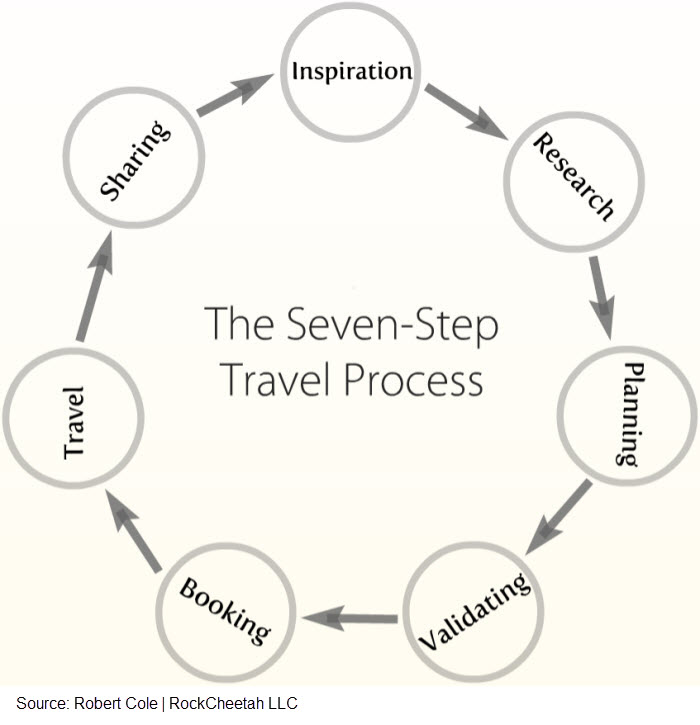Travelers are increasingly expressing frustration with the online travel experience. Forrester Research recently reported that only 1/3 of US online travelers feel that travel web sites do a good job presenting travel choices. Forrester continued in follow-on research to state travelers found hotel websites “generic, poorly organized, and confusing.” Especially during an economic downturn, this is not welcome news.

The old school approach to researching options for a trip. Online, is the only change that these are now in windows?
This third installment of How Google Can Help Revolutionize Online Travel, covers how Google can help online travel sellers communicate with travelers more efficiently to identify destinations worth consideration and present relevant information regarding compelling options for a journey.
Where the travel industry has wrestled with the best methods to inspire travel, online travel research is a relatively well developed phase of the seven-step travel process. In this cycle, the research step is preceded by inspiration, and followed by planning, validation, booking, travel and sharing.
Google, with its massive 70%+ traffic volume and expansive advertising network is in an excellent position to advance travel industry innovation by providing tools that provide solutions for the common challenges facing travelers researching travel online.
There are two major challenges impacting travel’s research phase:
First, the highly fragmented nature of travel, with its myriad destinations, forms of transport, lodging options, and attractions to be experienced (frequently over a highly compressed timeframe) provides travelers with daunting permutations and combinations of travel options. In a quest for relevant information, travelers are searching multiple sites including destination, hotel, airline, attraction, online travel company, guide book and social media sites to amass sufficient information to feel comfortable making a decision. PhoCusWright put the average at 3.7 websites in their 2009 Consumer Travel Report. To underscore the scope of this fragmentation, in the US, 91% of travelers search multiple internet sites when researching travel, 75% search more than three websites, and 20% are searching six or more sites. In 2007, a Google / Comscore click-stream study study found the travel research process on average began 7 weeks prior to making a travel booking and and involved an average of 8.1 searches. A greenbee.com study in January, 2009 that focused on UK consumers found that 34% of travelers spent a full day trying to find the best holiday deal. These statistics do not characterize an efficient process.
A considerable amount of travel-related content is maintained across a highly distributed and non-standardized network of internet sites. As a result, locating relevant product information can be a challenge. This does not discount the value of the Global Distribution Systems like Sabre, Travelport and Amadeus or ITA Software‘s great airfare technologies. These systems were primarily focused on basic textual information for the inventory and pricing tasks supporting the planning and booking phases of the travel cycle.
One particular challenge facing the travel research phase is the rich content demanded by travelers to feel comfortable with travel decisions. On an industry level, travel descriptive text, images and video involving destinations and hotels is not well organized due to an absence of reliable syndication and ongoing maintenance processes. Although groups like VFM Leonardo have made great strides and developed a sizable client base (especially stepping up to the task of managing the Pegasus content database) but there is considerable work to be done. With the benefits of a more contextual search through the Semantic Web looming on the horizon, initiatives will need to be undertaken to develop more context sensitive Resource Description Format (RDF) Schemas.
Second, to help support more highly targeted, more personalized results, travel research needs to become more persona-based. The same individual can easily have a half dozen different travel personas. For example, travel for a family vacation, business trip, weekend escape with a spouse, or attendance at an industry conference, may all be researched and booked by the same individual. Each type of trip however, could involve completely different objectives and decision processes. Unfortunately, most traveler profiles are currently one-dimensional, encompassing basic personal contact and demographic data. On occasions when more specific information is requested in a profile, it most often contains only general preferences that are not customizable for different types of trips.
Certain travel components and service levels are preferred for certain types of trips; consumers regard travel brands with variable degrees of loyalty; trips are planned with various levels of input from others; and in a recession, budgets are always an issue. Probing about a traveler’s conditional travel preferences can present a challenge if there is limited consumer benefit in return, but linking those intents to appropriate timing, frequency and message content can represent a significant opportunity. By embracing traveler personas, travel marketing initiatives can become more relevant to the consumer and more efficient for the travel seller.
Google currently provides a variety of tools that improve the state of online travel research. By mashing-up these tools, even greater benefits may be realized. This has been proven with local business information and maps, but similar synergies are available with many of the available tools provided by Google. The following section highlights the functionality of tools that benefit the travel research process and opportunities for future enhancement.
Google Tools for Travel Research
 |
Web Search What it does: If you didn’t realize Google did web search, you should stop reading right now. Please go clean your typewriter or reorganize your 8-track tape collection. Google’s constantly evolving PageRank algorithm strives to deliver the most relevant search results at the top of the list. What it can do: As search moves toward Web 3.0, the evolution of a semantic web, search will become more highly personalized with more relevant results as the technology improves its understanding of context. |
 |
Image Search What it does: Image search provides an additional dimension to web search by providing more compelling graphic content from search queries. What it can do: As publishers improve image meta data and technologies improve control over content syndication processes, image updating and replacement of expired image content will help provide travelers with the best information possible. |
 |
Video Search What it does: Google’s Video Search is separate from its YouTube video search. Video search provides results from the rest of the web in addition to YouTube. What it can do: For the travel industry, video provides an unparalleled opportunity to showcase not only destination or product features, but to create an environment that frames the traveler. As search becomes more personalized and context sensitive, videos produced for niche travel segments will deliver much more compelling and relevant content to travelers. |
 |
Blog Search What it does: Helps travelers locate pertinent information produced by the blogoshere. What it can do: Providing travelers with access to information provided by local in destination subject matter experts provides a invaluable new resource for researching potential options. In addition, monitoring of real-time microblogging services hold the potential to provide immediate access to communication regarding special offers or time sensitive access to precious inventory. |
 |
Custom Search What it does: Google customized search allows searches to be focused solely on a select group of websites, improving the relevancy of the search process and ensuring unwanted third party content is not introduced into the search results. What it can do: Travel sellers applying custom search capabilities can provide travelers with a more flexible search process, free of hierarchal site structures and navigation paths. By including content from trusted external sites, the user experience can be enriched without the risk of introducing low quality, improperly positioned or competitive information. |
 |
Accounts What it does: Google Accounts is the functionality that allows users to sign into GMail, iGoogle, etc. It also holds the Google profile information. This not only provides one with simplified site registration processes (Google supports OpenID standards), but more importantly, it enables users to customize pages, view recommendations, and get more relevant search results. What it can do: The Accounts profile information can be expanded to provide incredibly powerful travel research capabilities through personalization based on both defined and behaviorly implied preferences. By extending the profiling capability to support the management of multiple travel personas, travel search could be streamlined significantly – simplifying the process and saving users valuable time. This enhancement could represent a critical step forward in enabling much more highly personalized and context sensitive travel search processes promised by the Semantic Web. |
 |
Directory What it does: Google Directory organizes web searches by topic or category. Currently, there is not a travel category in Google Directory. What it can do: By developing a travel category for Google Directory, information may be organized by travel vertical, by supplier brand and destination. By improving the organization of the travel information, and simplifying access using a hierarchal structure, travelers will be able to more easily drill down into more specific tiers of information. |
 |
Reader What it does: Google Reader is a blog and news reader that keeps track of subscriptions, as well as statistics on the frequency of posts and the number of posts that have been read. What it can do: By consolidating Blog and News Feeds into categories, travelers can automatically receive content and maintain an organized filing system for various destinations or itineraries by using search, folders and tags across RSS feeds. |
 |
Translate What it does: Allows users to view web pages posted in foreign languages in their native language. Considering individuals residing in the local area would logically have the greatest familiarity with the destination, this tool potentially delivers unique content unavailable through other channels. Google Translate also offers the very cool feature of automatically detecting the foreign language. What it can do: As on-the-fly machine translation technology improves, this service becomes even more valuable. Currently, the full page is translated under a single language, but in the future, one could see benefit in translating a consolidated page with multiple reviews in different languages for a more comprehensive and current perspective. |
 |
Google Squared (Labs) What it does: Allows users to fetch and organize facts from across the web. Google Squared automatically constructs a table of facts about any category you specify. For example, a search of New York Hotels, returns a grid of 50 properties, each with a description, address, amenities, cuisine, facilities, services, Wi-fi, specialty, ambiance, specialty, neighborhood, and accepted payments. Los Angeles Museums presents 50 venues, each with a description, address, admission prices and cross-streets. What it can do: Future enhancements will undoubtedly include a broader selection of subject items. If the travel industry can provide improved data standardization, usability will increase dramatically. Adding results sorting and filtering capability will also help travelers research products and destinations. |
 |
Flu Trends (Labs) What it does: Cleverly provides up-to-date estimates of flu activity in the United States, Mexico, Australia & New Zealand based on frequency of statistically correlated web searches. An excellent example of how creatively utilizing one Google tool can create a second tool, Google Flu is based on the Google Insights for Search tool. What it can do: If Google can calculate the statistical relationship between web searches and the Flu, there should be opportunities to track popularity for particular destinations, holiday periods, or travel brands. |
 |
Google Audio Indexing (Labs) What it does: Google audio indexing may need to stay in the Labs for a bit longer as the machine audio-to-text transcription remains a little rough, but one can see the potential of unlocking the spoken word for search and providing users with an interface that links directly to the appropriate section of video footage regarding the topic. What it can do: Ultimately, this technology can dramatically increase the utility of both podcasts and video blogs by providing the same search capability that is currently used for web pages. Extended format travelogues, destination overviews and hotel virtual tours will no longer need to rely on proprietary chapter navigation or indexing schemes to enable direct access to content by consumers. |
Moving Forward
Of course Google can help the travel industry enhance its research capabilities by continuing to enhance the tools above and introduce even more innovative tools. Two specific initiatives could help the travel industry gain access to a broader range of more consistently structured data to align with a richer set of customer profile data. These areas can create the greatest potential for more efficient travel research processes:
Support for Travel Industry Standards
Google’s support for the Open Travel Alliance (OTA) open travel specifications would go a long way to help promote the interoperability of tools supporting the smooth flow of traveler and supplier information throughout travel, tourism and hospitality markets. While a large number of major airlines, hotel chains and rental car companies have implemented the OTA XML specifications to facilitate booking interfaces, considerable opportunity remains for increasing adoption of the standards to improve the presentation of descriptive text and image content – especially for destination, attraction and hotel websites.
Hospitality Technology Next Generation (HTNG) has a Distribution Content Management Workgroup with the objective of facilitating the collection, aggregation, management and distribution of descriptive and illustrative content to create a compelling user experience. Their goal is to create a single point of entry from which hotels can manage rich content in all connected distribution channels; with a similar single point of access for the distribution channels to source rich content from all connected hotels. HTNG collaborates extensively with the OTA to make the standards efficiently compliment the work accomplished by the other group.
By leveraging these standards, distribution channels benefit by reducing development timeframes and gain access to a broader range and depth of rich content. Suppliers, by adopting the standards, can increase exposure and better control the distribution and quality of the content made available to consumers. Travelers benefit with more consistent access to more current and better quality information. There are not many business opportunities that provide comparable win-win-win scenarios. Google’s support of these travel industry standards provide access to a huge source of traffic and satisfies Google’s stated core objective of organizing information by simplifying access to more relevant content.
Development of Persona-based Traveler Profiles
If properly structured and integrated, a persona-based travel profile can provide a valuable degree of granularity that can make travel search better aligned with true traveler needs. In addition to helping identify more relevant destination and hotel options based on expressed preferences, it can also help provide better situational search results. When access to persona-based data is authorized by travelers, persona-based profiles can make proactive marketing communication significantly more personalized for specific individuals and more relevant for specific itineraries.
Over time, the identification of more complex personas such as Loyalists (travelers that exhibit a tendency to book the same supplier or visit a common destination) or Explorers (travelers that continually visit new destinations or show no loyalty to specific suppliers) could provide valuable insights for travel marketers desiring to create highly personalized and relevant promotional messages to engage travelers.
Customer engagement is founded on two premises: a) trust between a traveler and the travel marketer, and b) utility, or the benefit a traveler derives from interacting with the travel marketer. Travel marketers capable of instilling trust and providing sufficient benefit to travelers will be rewarded with access to this valuable store of persona-based profile information. With access to this information, travel sellers will be able to gain a higher degree of customer engagement and win a greater share of the individual’s discretionary travel spend.
Significant opportunities exist for enhancing the research phase of the online travel process. These enhancements present the best an opportunity to reverse the recent trend toward the commoditization of online travel into a price-oriented comparison shopping process.
By appropriately aligning customer needs derived from persona-based profile information against a rich repository of product information efficiently and accurately sourced across a wide variety of travel suppliers or content aggregators, travel research can be simplified. Google, with its high search traffic and ubiquitous advertising scope, is well positioned to benefit by providing the travel industry with tools that enhance the travel research process and stimulate the booking of travel online.
The next installment will focus on the next step of the seven-step travel process: Planning.

Google provides many tools that contribute additional value to most phases of the online travel experience
[Note: This is the third in a series of eight articles contemplating how Google can help revolutionize online travel by improving the organization and accessibility of tourism related information. The radical democratization of travel information, a process Google has initiated through its search and advertising technologies, can increase commerce throughout the travel industry by fostering fair competition among hotels, airlines, destinations, attractions, and online travel companies – regardless of size or geography. – RKC]
Background:
Why Google Will Radically Democratize Online Travel
Other articles in the series:
How Google Can Help Revolutionize Online Travel (part 1)
How Google Can Help Facilitate Travel Inspiration (part 2)
How Google Can Help Simplify Online Travel Planning (part 4)









